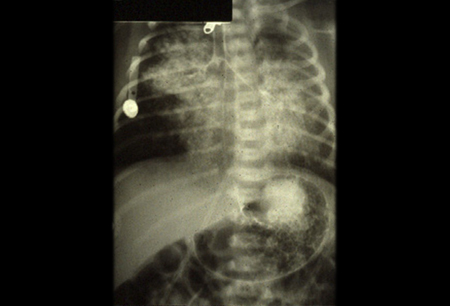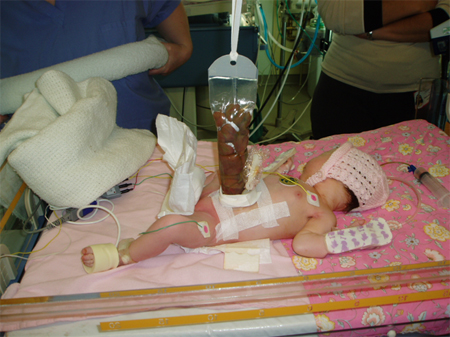Etiology
Feeding disorders are often multifactorial in etiology. Possible contributing factors are as follows.
Neurologic, neuromuscular, and neurodevelopmental disorders: hypoxic ischemic encephalopathy, cerebral palsy, spinal muscular atrophy, congenital myotonic dystrophy, myasthenia gravis, and muscular dystrophies. Infants with developmental delay are at least twice as likely as children with normal development to have difficulties with feeding. Up to 80% of children with complex feeding disorders have developmental delay.[4][7]
Anatomic abnormalities: cleft lip/palate, ankyloglossia (tongue-tie), tracheoesophageal fistula, gastroschisis (congenital fissure of the abdominal wall), and esophageal stricture/atresia. Structural anomalies accounted for 60% of referrals to one large US pediatric feeding team.[4][Figure caption and citation for the preceding image starts]: H-type tracheoesophageal fistula. CXR/tubogram demonstrating dispersion of radiopaque dye into the lung field when injected into NG tube positioned in esophagus. Dye is also noted in stomachFrom the collection of Dr Stephanie Gill [Citation ends].
 [Figure caption and citation for the preceding image starts]: Immediate management of gastroschisis (congenital fissure of the abdominal wall): bowel loop contained within a preformed silo bag. Despite early surgical correction, these babies have a high risk of dysmotility and feeding problemsFrom the collection of Dr Stephanie Gill [Citation ends].
[Figure caption and citation for the preceding image starts]: Immediate management of gastroschisis (congenital fissure of the abdominal wall): bowel loop contained within a preformed silo bag. Despite early surgical correction, these babies have a high risk of dysmotility and feeding problemsFrom the collection of Dr Stephanie Gill [Citation ends].
Surgical problems: stoma formation, short bowel syndrome, and hiatus hernia. Feeding disorders can occur following surgery: for example, esophageal dysmotility following repair of esophageal atresia or gastroschisis, or short bowel syndrome after bowel resection for severe necrotizing enterocolitis.[10][11][12]
Gastrointestinal disorders:
Gastroesophageal reflux disease (GERD): GERD symptoms have been reported in 25.5% of infants at 1 month of age, decreasing to 2.9% at 6 months.[13] Incidence is even higher in preterm infants, particularly in the presence of a feeding tube.[14][15]
Colic: reported in 5% to 19% of infants in the first months of life.[16]
Cows' milk protein allergy: affects approximately 2% of infants.[17][18]
Celiac disease: has an overall prevalence of approximately 1%.[19] Symptoms develop after introduction of gluten to the diet during weaning.
Lactose intolerance: primary lactose intolerance rarely causes clinical symptoms before 5 years of age, although lactase levels decline soon after weaning. Premature infants have much lower lactase activity than term infants, which can cause transient lactose intolerance. Congenital lactase deficiency is rare. Secondary lactose intolerance may be caused by viral gastroenteritis, giardiasis, cows’ milk protein allergy, celiac disease, or Crohn disease.[20]
Eosinophilic esophagitis: data on incidence is scarce, but this condition is reported in infants.
Genetic conditions (including Down syndrome and Pierre Robin sequence): accounted for 9% of patients referred to a European specialist feeding team.[3]
Congenital heart disease: infants with congenital heart disease experience prolonged hospitalization with intubation, delayed onset of enteral feeding, and higher incidence of GERD, which can collectively impair the acquisition and development of feeding skills.[1] Infants undergoing cardiac surgery, particularly for single ventricle repairs, are at increased risk of necrotizing enterocolitis and subsequent feeding dysfunction including food manipulation, choking and vomiting, aggressive behaviors at mealtime, and aversion to eating.[21][22] In a retrospective study of infants who underwent cardiac surgery in the neonatal period, 22% experienced feeding disorders defined as inadequate intake for appropriate age, failure to thrive, and need for nasogastric feeding.[23]
Bronchopulmonary dysplasia (chronic lung disease of prematurity): interrupts an infant's ability to coordinate the suck/swallow/breathe stages of feeding.[2] Infants tire easily during feeding and suckle less efficiently.[24]
Prematurity and intrauterine growth restriction: one third of patients referred with feeding disorders are born at <37 weeks' gestation.[3] Preterm infants have impaired coordination of suckling, swallowing, and breathing; slow gut transit times; decreased lactase activity; increased risk of GERD; and increased risk of surgery (e.g., stoma formation or bowel resection for necrotizing enterocolitis). Prematurity increases the likelihood of medical manipulation of the oropharynx (ventilation with endotracheal tube placement, tube feeds, oropharyngeal suctioning), which is postulated to increase sensory aversion, and lead to behavioral feeding difficulties.[3] Infants referred to tertiary centers for management of feeding disorders have a significantly lower birth weight for their gestational age, implying that feeding problems are associated with intrauterine growth restriction.[3]
Psychosocial factors: one US feeding team reported that 80% of the children seen had feeding problems complicated by behavioral issues.[4] The infant's learned response to feeding, and the caregivers' subsequent actions, can have considerable impact on feeding disorders.
Pathophysiology
Effective transit of liquid from the oral cavity to the stomach requires an infant to coordinate suckling, swallowing, and breathing. The infant must position their tongue and jaw around a nipple or teat, and generate suction to pull liquid into the mouth. Presence of liquid in the pharynx initiates swallowing. Breathing pauses during each swallow to prevent aspiration of the pharyngeal contents.
Coordination of this process is impaired by prematurity, neurologic and neuromuscular conditions, neurodevelopmental disorders, anatomic abnormalities of the oropharynx or esophagus, and cardiac and respiratory conditions that increase the work of breathing. Premature infants are neurologically immature and usually cannot coordinate the suck-swallow-breathe sequence before 34 weeks of corrected gestational age.[25] Neurologic, neuromuscular, and neurodevelopmental problems can also lead to poor coordination of the suckling, swallowing, and breathing sequence. This can increase time taken to feed (with an impact on satiety, digestion, and hunger), increase the risk of aspiration, and impair development of the oromotor skills needed to feed independently.[3][8][25] Anatomic problems such as micrognathia, cleft lip, and cleft palate disrupt the normal craniofacial anatomy, leading to an infant's inability to suck effectively. Increased respiratory rate and increased work of breathing at rest impair ability to feed.[8] These infants tire easily during feeds. Poor coordination, weak suck, and short sucking bursts are described in infants with severe bronchopulmonary dysplasia.[24]
Transit of food and liquid from the pharynx to the stomach requires effective esophageal peristalsis and transient relaxation of the lower esophageal sphincter. Esophageal dysmotility is associated with multiple causes of infant feeding disorders, including neurologic and neuromuscular conditions, developmental delay, and gastroschisis.
Gastrointestinal conditions may cause nausea or discomfort during feeding, contributing to the development of feeding disorders.
In many cases, the cause of feeding disorder is multifactorial. For example, premature infants have difficulty with the neurologic coordination of swallowing and have an immature digestive tract with reduced lactase activity, thus reducing nutrient absorption from feeds.
Behavioral issues such as food refusal have been linked to oral aversion, attributed to the unpleasant stimuli of orogastric tubes and endotracheal tubes passing through the mouth.[3]
Classification
A unifying diagnostic term of "pediatric feeding disorders" has been proposed, using the framework of the World Health Organization international classification of functioning, disability, and health.[1] This classification describes the effect of a feeding disorder on a child’s function, unifying medical, nutritional, feeding skills, and psychosocial concerns associated with the disorder and prompting assessment of both the underlying condition and functional limitations to direct optimal care plans.
Previously, medical, surgical, and nutritional problems causing feeding disorders have been classified as organic, whereas behavioral and psychological problems have been termed nonorganic.[3] However, many authors have criticized this classification as being too simplistic. Most feeding disorders are multifactorial in nature, and clinical symptoms are similar in both groups.[5][6] Furthermore, this classification does not aid either diagnosis or management, as many disorders will require input from a multidisciplinary team to achieve optimal results.
Use of this content is subject to our disclaimer